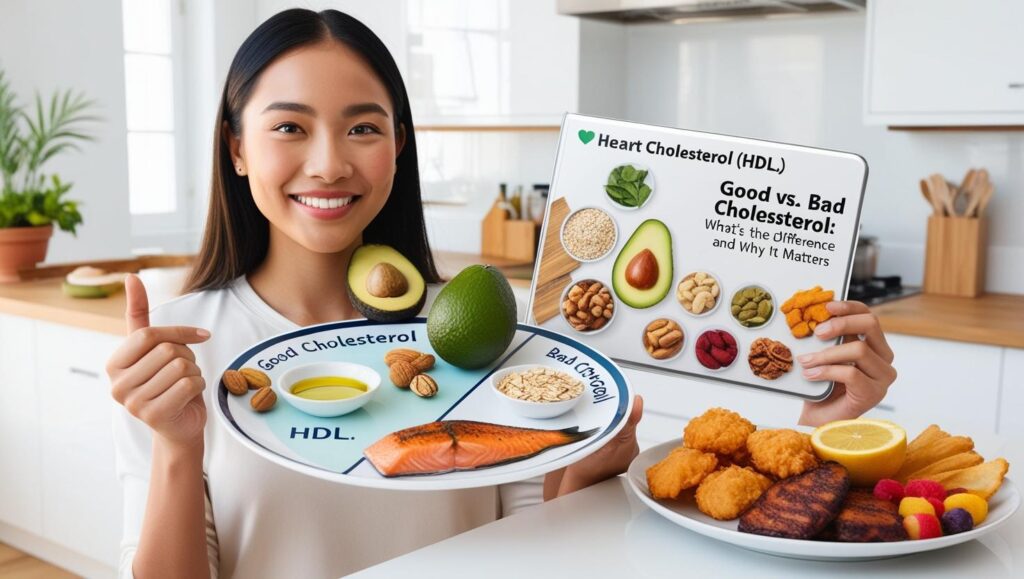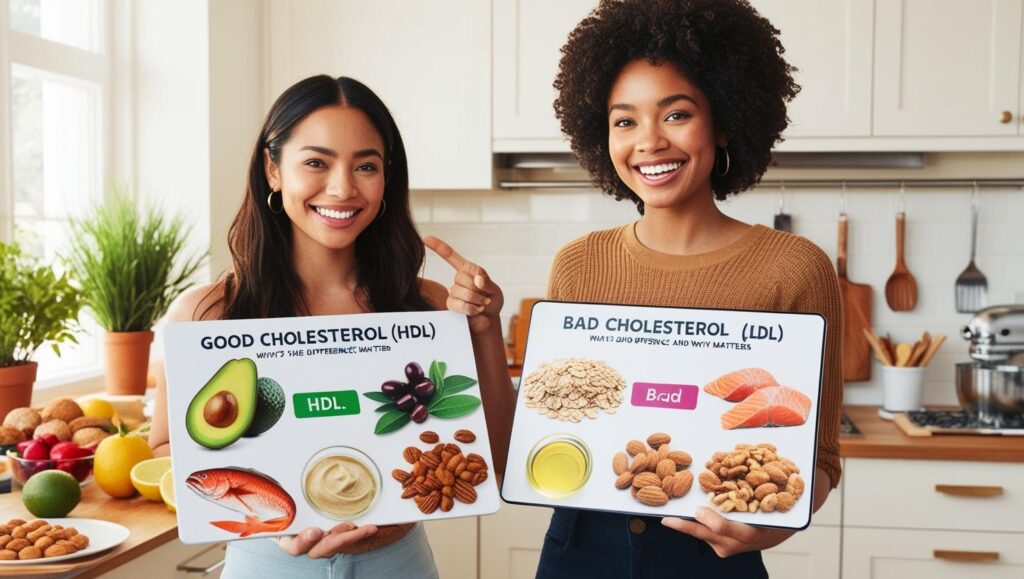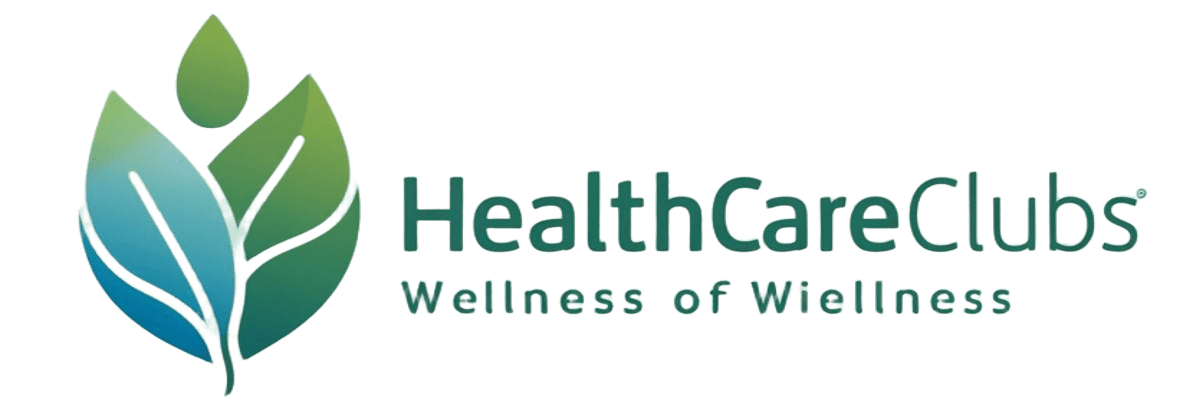With your health, cholesterol always receives a negative light. It might show up when we talk about heart disease or high blood pressure, all with a warning that you need to avoid it. All cholesterol is not created equal, though. Your body even requires cholesterol to function.
The trick is recognizing good and bad cholesterol—and knowing how to regulate your levels in order to safeguard your heart and overall well-being.
In this post, we’re going to analyze:
What is cholesterol?
The difference between HDL (good cholesterol) and LDL (bad cholesterol)
How Cholesterol Impacts Your Body

==============================
Practical Steps to Enhancing Your Cholesterol Profile Naturally
Let’s get started.
What is Cholesterol?
Cholesterol is a fatty, waxy material present in each cell in your body. It is needed for the production of:
- Hormones such as testosterone and estrogen
- Vitamin D
- Bile acids to digest fat
Most of the cholesterol your body requires is produced by your liver, but you also derive cholesterol from foods of animal origin such as dairy, eggs, and meat.
Because cholesterol is not soluble in blood, it is carried through your circulatory system by lipoproteins, which is where HDL and LDL enter the picture.
The two principal types of cholesterol are HDL and LDL.
✅ HDL (High-Density Lipoprotein): The “Good” Cholesterol
Function: HDL transports cholesterol out of your arteries and to the liver, where it is metabolized and expelled from the body.
Benefit: Having high HDL is linked with decreased risk for heart disease and stroke.
Ideal Level:
- Males: 40 mg/dL or more
- Women: 50 mg/dL or higher
Consider HDL your clean-up team—it takes away extra cholesterol from your blood and keeps it from accumulating in the arteries.
⚠️ LDL (Low-Density Lipoprotein): The “Bad” Cholesterol
Purpose: LDL transports cholesterol to your tissue, such as your arteries.
Risk: When there’s an excess of LDL in your blood, it can deposit inside the walls of your arteries, creating plaque. This is known as atherosclerosis and is a leading cause of heart attack and stroke.
Ideal Level:
- Ideally, it is less than 100 mg/dL
- Near optimal is 100–129 mg/dL
- Borderline high is 130-159 mg/d
- above >= 160 mg/dL is high
Total Cholesterol: What the Numbers Mean
When you have a cholesterol test or lipid panel, you will normally have four values:
- Total Cholesterol
- LDL Cholesterol (bad)
- HDL cholesterol (good)
- Triglycerides are another form of blood fat.
Ideal Lipid Panel Numbers:
| Component | Maximum Level |
|---|---|
| Total Cholesterol | Lower than 200 mg/d |
| LDL Cholesterol | Lower than 100 mg |
| HDL Cholesterol | ≥50 mg/dL in women, ≥40 mg/dL in men |
| Triglycerides | < 150 mg |
Export to Sheets
Why High LDL Cholesterol is Hazardous
High cholesterol can cause atherosclerosis, where cholesterol accumulates in the arteries, narrowing them and reducing blood flow. This can lead to:
- Myocardial infarction
- Stroke
- Peripheral artery disease
- Chronic Kidney Disease
What is particularly alarming about this is the fact that high levels of cholesterol often have no symptoms—another reason why cholesterol testing is essential.
How Does HDL Help Protect the Heart?
HDL assists with:
- LDL removal from the blood
- Delivering cholesterol to the liver for elimination
- Antioxidants, which inhibit oxidation, prevent damage to blood vessel walls
- Reducing inflammation of arteries
Increased HDL is associated with improved cardiovascular health, although excess of it (occasionally) can cause issues as well.
Factors That Influence Your Cholesterol Levels
Cholesterol is determined by the synergy of genetics, diet, and lifestyle. This is how they each factor in:
Genetics
Certain individuals have inherited genes leading to high cholesterol (familial hypercholesterolemia).
Diet
- Increased consumption of saturated and trans fats elevates the levels of LDL.
- High soluble fiber foods such as oats, beans, and apples can reduce LDL.
- Omega-3 fatty acids from fatty fish can increase HDL and reduce triglycerides.
Physical Activity
Exercise both increases HDL and decreases LDL.
Cigarette use
Reduces HDL and makes the LDL more dangerous by increasing its oxidation.
Weight
Thus, excess weight increases both triglycerides and LDL, reducing HDL.
Foods That Help Your Cholesterol Numbers
To increase HDL (Good) Cholesterol:
- Olive oil
- Fatty fish like salmon, sardines
- Nuts and seeds
- Whole grains
- Exercise regularly
⚠️ To reduce LDL (Bad) Cholesterol
- Oats and barley contain soluble fiber.
- Legumes and beans
- Pectin-containing fruits like grapes, citrus fruits, and apples
- Vegetables (especially leafy greens)
- Soy products (tofu, soy milk)
- Restrict red meats and full-fat dairy products
Cholesterol Myths Exposed
Myth #1: All cholesterol is bad.
Truth: Your body does require cholesterol, and it’s only an issue when it’s not in balance.
❌ Myth #2: High cholesterol is only present in obese individuals.
✅ Fact: Thin individuals may have high cholesterol, often due to genetic or lifestyle factors.
❌ Myth #3: High cholesterol makes you feel sick.
The truth is: High cholesterol is often silent and can only be detected with a blood test.
❌ Myth #4: Eggs are detrimental to your cholesterol.
✅ Fact: Cholesterol in the diet (such as eggs) has relatively little effect on blood cholesterol compared with saturated and trans fats.
When to Have Your Cholesterol Checked
The American Heart Association states:
- Adults aged ≥20 need to have their cholesterol checked every 4-6 years.
- If you have risk factors (family history, diabetes, smoking), you might need to do the test more often.
Speak with your healthcare provider to find out which schedule is best for you.
Lifestyle alterations to enhance cholesterol naturally

- Eat a heart-healthy diet: Concentrate on whole foods, healthy fats, and fiber.
- Exercise regularly: Get at least 150 minutes of moderate-intensity physical activity each week.
- Be at a healthy weight: Reducing your weight by even 5–10% can make a difference.
- Quit smoking: This benefits HDL and reduces risk of heart disease.
- Restrict alcohol: Excessive alcohol use may increase triglycerides.
- Relieve stress: Ongoing stress impacts your hormone balance and heart.
When Are Medications Necessary?
If lifestyle modifications are not sufficient, your healthcare provider may recommend statins or other lipid-lowering medications, particularly if: Your LDL is very high. You have had one of the following: You have diabetes or other risk factors Medication works best when coupled with positive habits.
Conclusion: Get to know your numbers, guard your heart.
Cholesterol is not your enemy—but unbalanced cholesterol can prove detrimental. Knowing HDL’s and LDL’s roles is the first step towards managing your heart health. By making small daily choices such as consuming more fiber, exercising your body, and avoiding processed foods, you can enhance your cholesterol naturally.
❤️ Key Points:
- HDL is “good” cholesterol, which helps guard your arteries.
- LDL is the “bad” cholesterol responsible for heart disease.
- Healthy living can increase HDL and decrease LDL.
- Regular cholesterol checks are necessary—even if you’re feeling perfectly fine.
Your heart, though, will appreciate each little alteration.Sources and related content
![]()






